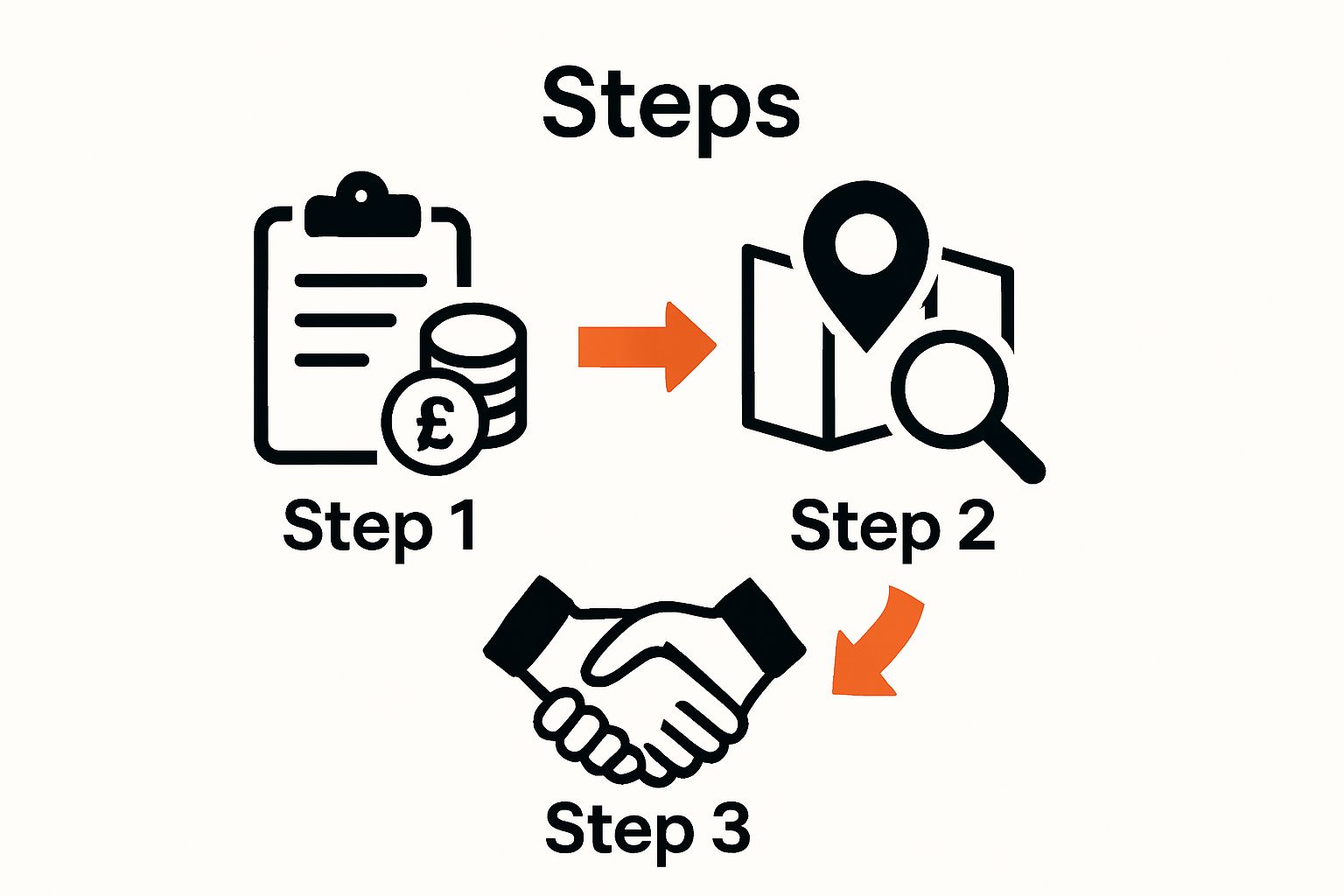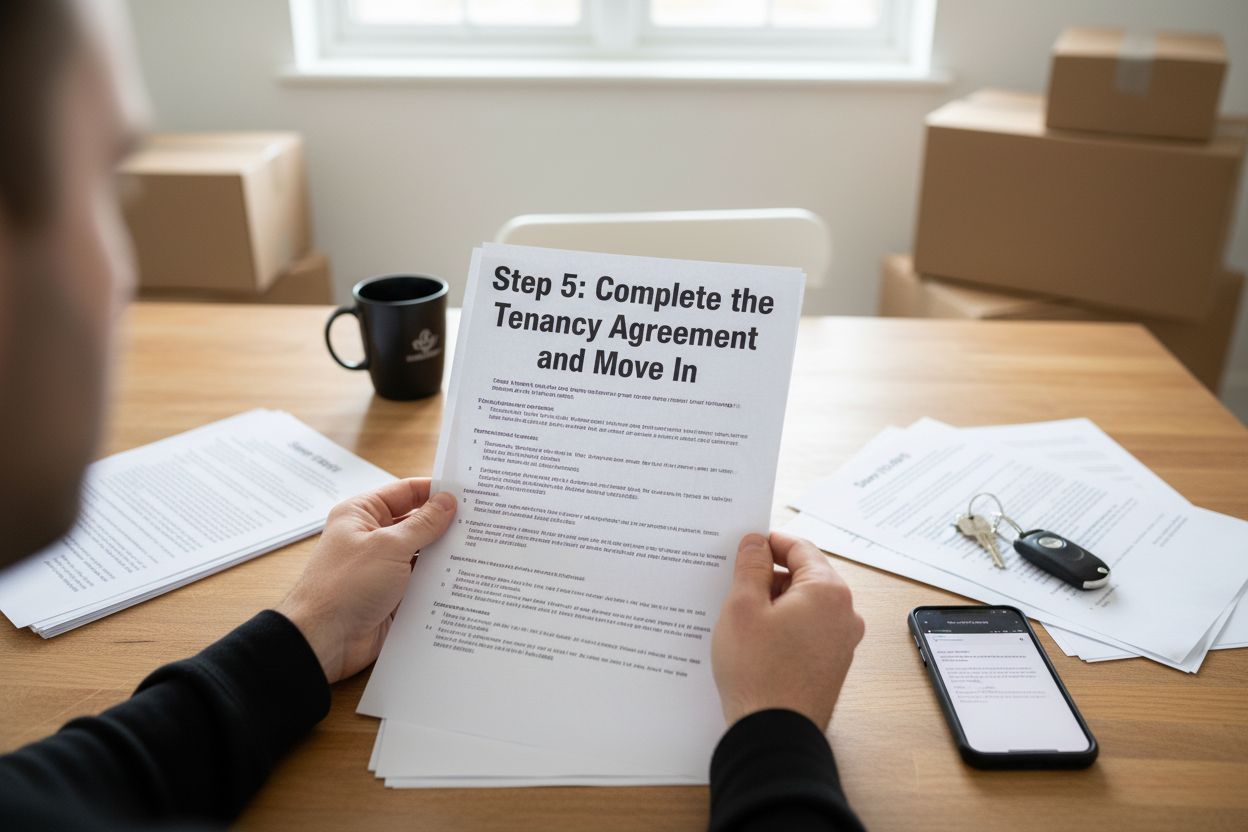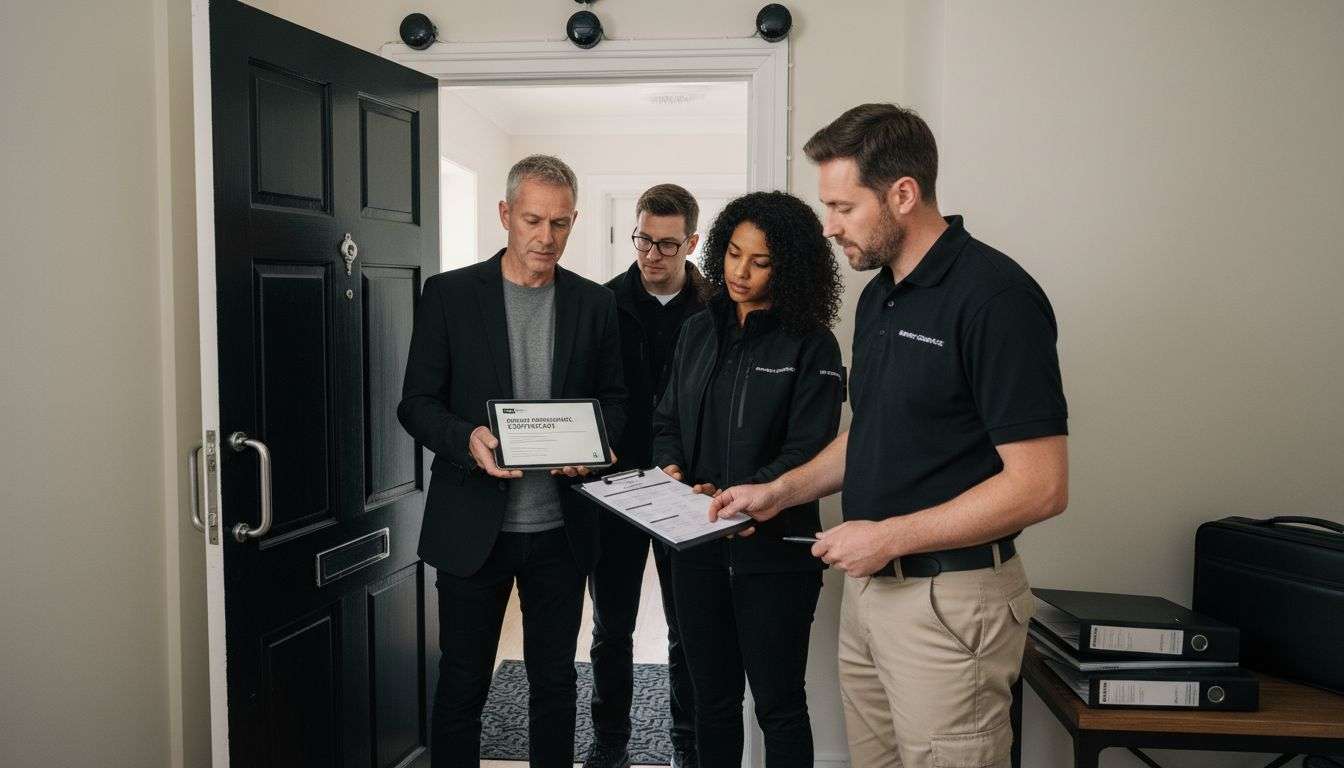Finding the right HMO accommodation can feel like searching for a needle in a haystack when choices seem endless and financial traps hide in plain sight. Most people believe you need to view dozens of places before you get anywhere close to a good fit. The reality is that a carefully defined set of personal requirements at the start will save you from wasting hours on unsuitable properties and immediate disappointment. The smartest house-hunters never rely on chance and this simple shift could change the way you search forever.
Quick Summary
| Key Point | Explanation |
|---|---|
| 1. Define your requirements and budget | Identify personal living needs and financial limitations to streamline your property search effectively. |
| 2. Research HMO properties diligently | Use multiple channels for property listings and gather local market insights before making decisions. |
| 3. Prepare a comprehensive communication package | Collect necessary documentation to present yourself as a reliable tenant to landlords and property managers. |
| 4. Conduct thorough property viewings | Assess each property carefully, focusing on practical details and overall living conditions to ensure a good match. |
| 5. Review tenancy agreements meticulously | Understand the legal obligations in your contract to avoid future disputes and ensure a harmonious living experience. |
Step 1: Define Your Requirements and Budget
Locating the right House in Multiple Occupation (HMO) accommodation starts with a strategic and thorough understanding of your specific requirements and financial boundaries. This initial step is crucial in narrowing down potential options and ensuring you find a living space that matches both your practical needs and budgetary constraints.
Begin by creating a comprehensive assessment of your personal living requirements. Consider factors such as the number of occupants, preferred location proximity to work or educational institutions, desired amenities, and specific room configurations. Detailed personal profiling at this stage prevents wasted time and energy pursuing unsuitable properties.
Your budget evaluation needs meticulous attention. Calculate not just the monthly rental cost, but include additional expenses like utility bills, council tax, potential maintenance contributions, and mandatory HMO licensing fees. Professional HMO investors recommend allocating approximately 40-45% of your monthly income towards total housing expenses. This approach ensures financial stability while preventing potential overextension.
Key Financial Considerations for HMO Accommodation:
- Base monthly rent
- Utility cost estimates
- Council tax responsibilities
- Potential shared maintenance expenses
- Initial deposit requirements
- Administrative fees
Research local HMO market rates through Rightmove’s HMO Rental Guide to understand pricing structures in your desired area. Different regions exhibit significant variations in HMO pricing, so comprehensive regional research becomes paramount. Urban centres typically command higher rates compared to suburban or rural locations.
Consider your personal lifestyle and compatibility with shared living arrangements. HMO accommodations require a certain level of social adaptability and willingness to coexist with other tenants. Reflect on your communication style, cleanliness standards, and tolerance for shared spaces. These personal attributes significantly impact your potential satisfaction with HMO living.
Document your requirements systematically. Create a structured spreadsheet or digital document outlining must-have features versus nice-to-have amenities. This approach transforms an abstract search into a methodical process, helping you communicate clearly with potential landlords or property management agencies. Prioritize your non-negotiable requirements while maintaining flexibility on secondary preferences.
By comprehensively defining your requirements and establishing a realistic budget, you transform the HMO accommodation search from a potentially overwhelming experience into a structured, manageable journey towards finding your ideal shared living space.
Step 2: Research HMO Properties in Your Target Area
Researching HMO properties demands a structured and comprehensive approach that goes beyond casual browsing. This critical step transforms your initial requirements into actionable property search strategies, enabling you to identify potential accommodation that precisely matches your needs.
Start by mapping out your target geographical area with precision. Consider proximity to key infrastructure like public transport, workplaces, educational institutions, and essential amenities. Digital mapping tools like Google Maps become invaluable in visualising potential locations, allowing you to understand neighbourhood dynamics and accessibility factors that significantly impact living experience.
Utilize multiple property search platforms to broaden your research scope. Mainstream websites like Rightmove and Zoopla offer extensive HMO listings, but specialist platforms provide more nuanced options. Explore our comprehensive guide on HMO property sourcing to understand the intricate landscape of HMO accommodation searching.
Critical Research Channels:
- Online property portals
- Local estate agent websites
- University accommodation boards
- Social media marketplace groups
- Professional HMO letting agencies
Engaging with local estate agents specialising in HMO properties can unlock opportunities not publicly advertised. These professionals often have insider knowledge about upcoming availabilities and can provide insights into specific neighbourhood characteristics that online listings might not reveal. Schedule initial consultations to discuss your requirements and establish a professional relationship.
Verify each potential property’s legal compliance meticulously. Local councils maintain public registers of licensed HMOs, which you can cross-reference to ensure the property meets regulatory standards. Pay particular attention to safety certifications, room size regulations, and shared space requirements specific to HMO accommodations.
Develop a systematic tracking method for your property research. Create a detailed spreadsheet documenting each potential property, including critical details like rental cost, location, room specifications, included utilities, and additional fees. This organised approach prevents information overload and helps you make objective comparisons.
Remember that successful HMO property research is not just about finding a space but discovering a living environment that aligns with your lifestyle and personal requirements. Take time to read tenant reviews, understand the property management approach, and visualise yourself in the potential living space. Your thorough research now will prevent potential disappointments and financial complications in the future.
Step 3: Contact Property Management Companies or Landlords
Initiating direct communication with property management companies and landlords represents a pivotal moment in your HMO accommodation search. This step transforms your research into tangible opportunities, requiring strategic preparation and professional engagement to successfully secure your ideal living space.
Preparation is paramount before making initial contact. Compile a comprehensive information package about yourself, including proof of income, references, employment verification, and a brief personal statement. This professional approach demonstrates reliability and increases your credibility with potential landlords. Digital communication tools like email provide an excellent record of interactions and allow for thoughtful, measured responses.
Learn more about HMO property management strategies to understand the nuanced dynamics of tenant-landlord relationships. When reaching out, craft concise, clear messages that highlight your suitability as a tenant. Explain your requirements, timeline, and any specific needs that might distinguish you from other potential occupants.
Essential Communication Elements:
- Professional email introduction
- Clear statement of housing requirements
- Proof of financial stability
- Professional references
- Preferred move-in timeline
Telephone conversations complement written communication, offering opportunities to gauge interpersonal compatibility and ask nuanced questions about the property. Prepare a structured list of inquiries covering critical aspects like utility inclusions, maintenance responsibilities, shared space protocols, and potential additional fees. Active listening during these conversations can reveal subtle details about the property and management style.
Understand that property management interactions are governed by specific legal frameworks protecting both tenant and landlord interests. Request comprehensive documentation including tenancy agreements, safety certificates, and inventory lists. Professional landlords will welcome transparent communication and provide these documents willingly.
Schedule property viewings strategically. Request multiple time slots to accommodate your schedule and demonstrate flexibility. During viewings, maintain a professional demeanour while conducting thorough assessments. Observe shared spaces, assess cleanliness standards, and evaluate overall property maintenance. Take detailed notes and photographs with permission, enabling later comparative analysis.
Maintain a systematic approach by documenting every interaction. Create a dedicated folder tracking correspondence, viewing notes, and potential properties. This organisational method prevents confusion and enables informed decision making.
Below is a checklist table to help ensure you gather and organise all necessary documents and details before contacting landlords or property management companies.
| Required Item | Purpose | Notes |
|---|---|---|
| Proof of income | Demonstrates financial stability | Recent payslips, bank statements |
| Professional references | Provides credibility and reliability | Previous landlord or employer |
| Employment verification | Confirms employment status | Letter or contract |
| Personal statement | Introduces you to the landlord/agent | Brief, highlight suitability |
| Preferred move-in timeline | Communicates intended start date | Be clear but flexible if possible |
| Housing requirements summary | Clarifies your needs for the landlord/agent | Include essentials and preferences |
| Remember that finding the right HMO accommodation is a process requiring patience, diligence, and strategic communication. |
Step 4: Arrange Viewings and Assess Property Conditions
Arranging property viewings represents a critical junction in your HMO accommodation search, transforming abstract research into tangible opportunities. This step demands a systematic approach, combining keen observation with strategic assessment to determine whether a potential property truly meets your living requirements.
Scheduling multiple viewing times allows comprehensive property evaluation. Contact property managers to arrange flexible viewing slots, preferably during daylight hours when natural lighting reveals subtle property characteristics. Request permission to conduct a thorough inspection, understanding that professional landlords appreciate methodical and respectful tenants.
Read our comprehensive guide on buying HMO properties to understand the nuanced aspects of property assessment. During viewings, develop a structured evaluation framework that goes beyond aesthetic considerations. Examine structural integrity, assess shared space functionality, and evaluate overall property maintenance standards.
Critical Viewing Assessment Checklist:
- Room dimensional measurements
- Natural lighting conditions
- Electrical socket availability
- Heating and insulation quality
- Shared space cleanliness
- Noise levels
- Structural maintenance indicators
Practical preparation enhances your viewing experience. Bring a measuring tape to confirm room dimensions, a smartphone for photographic documentation, and a notebook for detailed observations. Verify internet connectivity by testing mobile signals and inquiring about broadband infrastructure. Examine window conditions, assess storage possibilities, and understand the practical livability of each space.
Housing safety regulations mandate specific standards for HMO accommodations. Request comprehensive safety documentation including gas safety certificates, electrical installation condition reports, and fire safety assessments. Professional landlords will readily provide these documents, demonstrating transparency and commitment to tenant welfare.
Engaging with current tenants, if possible, offers invaluable insights into daily living experiences. Politely inquire about maintenance responsiveness, community dynamics, and potential challenges. Their candid perspectives can reveal nuances that formal property descriptions might obscure.
Conduct a methodical comparison across viewed properties. Create a standardised scoring system evaluating each property against your initial requirements. Consider factors beyond physical attributes: proximity to transportation, neighbourhood safety, and potential for personal comfort. Your comprehensive assessment transforms property viewing from a passive experience into a strategic decision-making process.
Here is a table summarising key factors to assess during your HMO property viewing, ensuring you do not overlook any crucial aspect of the accommodation.
| Assessment Factor | What to Check | Why It Matters |
|---|---|---|
| Room size and measurements | Confirm dimensions match your requirements | Ensures adequate personal space |
| Natural lighting | Observe windows and daylight levels | Affects wellbeing and comfort |
| Condition of shared areas | Look at kitchen, bathrooms, living spaces | Reflects property management standards |
| Maintenance indicators | Check for damp, damage, disrepair | Reveals quality of upkeep |
| Electrical socket access | Count accessible sockets in room | Practicality for devices and work |
| Heating and insulation | Test radiators, ask about insulation | Comfort and energy efficiency |
| Noise levels | Listen for external/internal noise | Impacts daily life and rest |

Step 5: Complete the Tenancy Agreement and Move In
Completing your tenancy agreement and transitioning into HMO accommodation represents the final culmination of your meticulous property search. This critical phase demands careful attention to legal documentation, financial preparations, and strategic planning to ensure a smooth move-in experience.
Thoroughly review your tenancy agreement before signing, treating it as a comprehensive legal contract that defines your living arrangement. Each clause requires careful scrutiny, understanding the specific obligations for both tenant and landlord in an HMO environment. Pay particular attention to shared space usage guidelines, maintenance responsibilities, and any unique provisions specific to HMO living arrangements.
Check our comprehensive HMO legal checklist to ensure you understand all contractual nuances. Professional tenants approach this stage with a methodical mindset, creating digital and physical copies of all documentation for future reference. Request a detailed inventory documenting the condition of your private and shared spaces, photographically recording any pre-existing damages to prevent potential disputes during contract termination.
Essential Move-In Documentation:
- Signed tenancy agreement
- Property inventory report
- Utility meter reading records
- Safety certification copies
- Contact information for property management
- Deposit protection scheme details
UK housing regulations mandate specific tenant protections, including mandatory deposit protection schemes. Confirm your landlord has registered your deposit with an approved scheme, typically within 30 days of payment. Request written confirmation and independently verify the registration to safeguard your financial interests.
Financial preparation extends beyond initial rent and deposit payments. Budget for initial setup expenses like basic kitchenware, bedding, and potential shared utility contributions. Communicate proactively with existing tenants to understand typical monthly utility cost divisions and any communal purchasing arrangements.
During move-in, conduct a comprehensive personal assessment of the property. Test electrical outlets, verify heating functionality, and assess shared space cleanliness. Document and immediately report any discrepancies between the property’s current state and the agreed inventory. Establishing clear communication channels with property management from the outset sets a positive precedent for your tenancy.
Successful HMO accommodation integration requires more than legal compliance. Approach shared living with openness, respect, and a collaborative spirit. Introduce yourself to fellow tenants, understand communal living protocols, and contribute positively to the shared living environment. Your proactive and professional approach transforms a mere rental agreement into a harmonious living experience.

Discover the Easiest Way to Secure Your Ideal HMO Accommodation
You have just learned the detailed steps for navigating the complex HMO market, from defining your requirements to signing your agreement. Yet the reality of finding a safe, compliant, and affordable HMO can still feel overwhelming. Sorting through endless listings, comparing legal standards, and negotiating with landlords often leaves tenants frustrated and unsure where to turn for trusted options.
Take the stress out of your HMO search by exploring https://agenthmo.co.uk. Our platform streamlines your entire journey. You will find:
- Verified HMO property listings suited to every budget
- Access to professional letting agents and expert property managers
- Up-to-date safety and compliance guidance tailored to UK regulations
Why settle for uncertainty or miss out on the best opportunities? Join the UK’s most specialised HMO community today and unlock trusted accommodation, industry insights, and resources all in one place. Start your search with confidence now and let your next home be just a few clicks away.
Frequently Asked Questions
How do I define my requirements for HMO accommodation?
Begin by assessing factors such as the number of occupants, preferred location, desired amenities, and specific room configurations. Create a detailed list to clearly communicate your needs to property management agencies.
What budget should I consider for HMO accommodation?
Calculate your monthly rental budget, including rent, utilities, council tax, and other fees, to allocate around 40-45% of your income. Document your total expenses to ensure you remain within your financial limits while searching for suitable properties.
How can I effectively research HMO properties in my target area?
Utilise multiple online property platforms and engage with local estate agents who specialise in HMO properties. Create a tracking spreadsheet to log key property details, helping you compare your options more efficiently.
What key elements should I ask about when contacting landlords or property management?
Reach out with clear questions regarding rental costs, maintenance responsibilities, and shared space rules. Prepare a list of inquiries in advance to ensure you collect all necessary information during your communication.
What should I look for during property viewings?
During viewings, assess room dimensions, natural lighting, and condition of shared spaces and facilities. Bring tools like a measuring tape and take detailed notes to facilitate a thorough comparison of properties afterwards.
What documents are essential when finalising my tenancy agreement?
Review your tenancy agreement carefully, ensuring you understand obligations for both tenant and landlord. Make sure to obtain key documents like the property inventory report and safety certificates before moving in.



